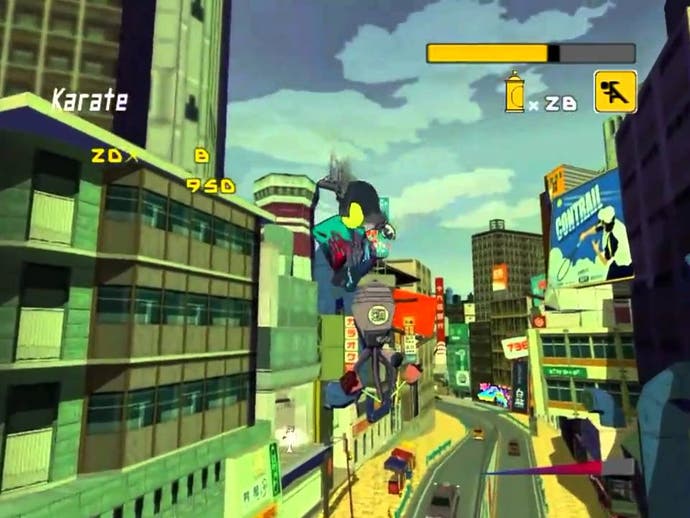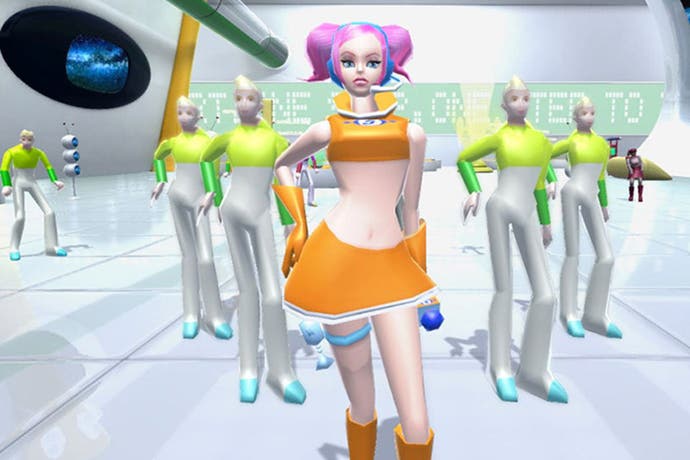Mizuguchi in Tokyo: When Sega made art from the arcade spirit
Dreams cast.
I waited for him on a street corner in Shibuya. It was the spring of 2000 - my first time in Japan. I was attending the Tokyo Game Show as editor of DC-UK magazine. Somehow I'd managed to score an interview with Tetsuya Mizuguchi, the impossibly cool Sega designer, once an upcoming arcade star, working on titles such as Sega Rally and Touring Car Championship, but now a wayward pioneer, leading his team at United Game Artists on Space Channel 5 and Rez.
I knew about Mizuguchi as a designer of course, but also as a person - a few years before, he'd made friends with my then-editor at Edge, Jason Brookes. The two went clubbing together in Tokyo, London and Bristol, both equally absorbed by the late-1990s dance music culture. I'd heard wild tales of their adventures. The year before my Tokyo trip, Jason and Edge writer Simon Cox had visited Mizuguchi's studio, and, just before the trio hit some weird hippy trance club, Mizuguchi showed them an early version of Rez.

"He said he didn't have a name for it yet, but the placeholder music was Underworld's Cowgirl/Rez," recalls Simon. "I said he should call it Rez because of the track but also because it reminded me of Tron and when you die in that you're de-rezzed. Tetsuya loved the idea. He was asked about it years later and couldn't remember exactly who named it, but Jase reminded him I think. Anyway we both got mentions in the credits."

It was Simon who'd got me the meeting with Mizuguchi and he was due to catch up with us later. For now, I was standing on this corner, watching the crowds rush by, thinking about Rez. And then, striding along a vast pedestrian crossing came Mizuguchi himself, his long coat flapping in the evening breeze, a giant video screen reflected in his sunglasses. That moment, that one moment of utter cool and anticipation, symbolised for me the Sega of 1999 and 2000. The Sega of the Dreamcast era. There was something about the Dreamcast, and the games Sega made during this period, that felt utterly local, utterly beholden to the Tokyo aesthetic. Space Channel 5 was a key example, its sleek 1960s retrofuturism, its gachapon-gift aliens, it's candy-coloured kawaii-fierce lead character, all drawing on the design culture of the city, while also referencing everything from Doraemon to Barberalla.

Jet Set Radio, one of the first open-world-ish action-adventure games, chose as its milieu the city's most famous districts - Shibuya and Shinjuku. With a development team made up almost entirely of twenty-somethings, director Masayoshi Kikuchi set out to capture what was truly cool about these areas; the vibe, the visual dynamism, the incredible effervescence, but also the dirt and grunge. This was a Tokyo of speed and neon, but also bus stations and concrete underpasses. It was fantastical but grounded in a way only natives could know. The game's stars were skaters and rappers, dressed in hi-tech variations on the Ganguro and Bōsōzoku street fashions of the era. The art team made the best use yet of cell-shaded visuals, containing the characters' super-flourescent colours, striped dresses and logo t-shirts within buzzing black outlines, like hastily caught sketches.
When you look at Jet Set Radio and Rez now, it's clear Sega's studios were really thinking about the future of video game design - they were channelling the music, imagery and dynamism of Tokyo into fresh interactive experiences. With each new console generation, manufacturers often talk about photographic realism as the ultimate aim, but with the Dreamcast and its Naomi arcade offshoot, the instinct seemed to be more transgressive - it was about using the technology to explore different visual ideas and possibilities. Rez treated sound as a material, as a physical realm, its graphics providing a kind of three-dimensional score to the thumping beats. Crazy Taxi and Jet Set Radio both created cities that were weird and loud and primary-coloured rather than cities that resembled the real world. Sometimes, I wonder if Sega knew the end of was coming when it began to support the Dreamcast with games such as these, and with Seaman, SegaGagaga and ChuChuRocket - if it thought there was a future, how could it have been so brave, so reckless?
Mizuguchi introduced himself to me, and gestured for me to follow him through the streets, past the pachinko parlours and noodle bars, beneath fizzing electric signs; I stumbled along in his wake, as he parted the groups of schoolkids and businessmen before him. I thought, this is what the Dreamcast has been doing - it's been leading us in, it has been giving us games that show us the places they were made and the people who made them. I'd spent years playing Japanese RPGs, shooters and fighting games, but they hadn't really told me about this place. I was learning now.
Earlier that day I'd been to Sega HQ which at the time was in a quieter more suburban part of Tokyo. We got off the train, and walked through residential areas and I recalled thinking, oh god, I'm in Shenmue. I mean, obviously I wasn't, because Shenmue is set in Yokosuka, but here I witnessed for the first time, the same sort of urban architecture, the wide quiet backstreets and low, flat houses, the pristine vending machines on each corner. Yu Suzuki had often drawn inspiration from the West - touring Europe and the US for Out Run, recreating Top Gun for Afterburner - but for Dreamcast he had come home, and in doing so, he had created a new type of open world game, in which free time, wandering and living were as important as adventuring.
Mizuguchi took me to a little seafood restaurant; Simon and Mizuguchi's assistant were there waiting for us when we arrived. He bought us champagne and oysters and we talked about old school hip-hop - he was so relaxed and affable, so interested in music and art; his games reflected that. It was a truly lovely evening, I'll never forget it, and for me it is inextricably linked to my affection for the Dreamcast. It was a machine of possibilities, an avant garde project in an industry of market-testing and focus groups and lists of specifications and poly counts. The Dreamcast memory card was a mini handheld for god's sake. Whoever though that was a workable idea? But then, in the spring of 2000, I went to Tokyo and I met Mizuguchi and it made sense. It all made sense.
The Dreamcast wasn't built to beat PlayStation 2 at its own game, it was built to play something entirely different. The Sega games of that era drew on everything we understood about Tokyo and Japan, and a hell of a lot we didn't, and expressed those things in a vital new way. I will always remember how I felt when I played Jet Set Radio and Rez, and Shenmue and Typing of the Dead and Seaman. They were taking us somewhere new and I wanted to go so badly.
That night I would have followed Tetsuya Mizuguchi anywhere.








.png?width=291&height=164&fit=crop&quality=80&format=jpg&auto=webp)

